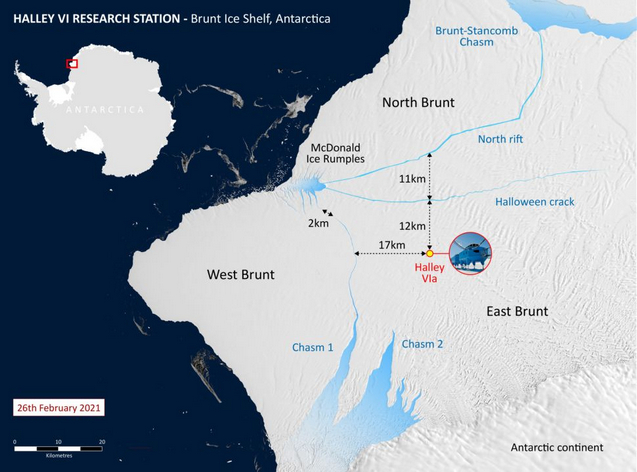The iceberg broke off from Antarctica's Brunt Ice Shelf on Feb. 26.

|
|
This giant iceberg broke off from Antarctica's Brunt Ice Shelf on
Feb. 26, 2021. (Image credit: contains modified Copernicus Sentinel data
(2021), processed by ESA, CC BY-SA 3.0 IGO) |
The iceberg, called A-74, covers about 490 square miles (1,270 square kilometers), making it 1.5 times bigger than Greater Paris. It broke off from the northern region of Antarctica's Brunt Ice Shelf on Feb. 26, just a few months after a large crack formed in November 2020.
The new images of the iceberg's big break were captured by the European Space Agency's (ESA) Copernicus Sentinel-1 mission, an Earth-observing project made up of two orbiting satellites: Sentinel-1A and Sentinel-1B.
"Although the calving of the new berg was expected and forecasted some weeks ago, watching such remote events unfold is still captivating," ESA scientist Mark Drinkwater said in an ESA statement about the event and how incredible it is to watch it all happen from space.

|
|
A map shows the Halley VI research station in relation to the
north rift crack. (Image credit: British Antarctic Survey) |
These scientists have been expecting a large "calving event" for at least a decade, according to the BAS. Ice calving, or iceberg or glacier calving, occurs when large pieces of ice break off of a glacier. The team working at the BAS Halley Research Station say that the station is unlikely to be affected by the recent calving event, according to the same BAS statement.
The Brunt Ice Shelf, which typically flows west at about 1.2 miles (2 kilometers) per year, routinely experiences calving events. According to the BAS in the same statement, there is "no evidence that climate change has played a significant role" in this specific event.
Pine Island Glacier in Antarctica gives birth to an iceberg the size of Malta.
In November 2020, a new chasm (or deep fissure) named the North Rift started quickly cutting across the ice shelf, moving about 16 feet (5 meters) per day, according to the same ESA statement. Finally, on Feb. 26, the crack spread apart, widening before the iceberg was completely free from the ice shelf.
"Over the following weeks and months, the iceberg could be entrained in the swift south-westerly flowing coastal current, run aground or cause further damage by bumping into the southern Brunt Ice Shelf. So we will be carefully monitoring the situation using data provided by the Copernicus Sentinel-1 mission," Drinkwater added.
Links
- A Huge Iceberg That's Bigger Than New York City Broke Off Near A UK Base In Antarctica
- Huge Antarctic Iceberg Headed Towards South Georgia Breaks In Two
- World's Biggest Iceberg Captured By RAF Cameras
- Why Scientists Are So Worried About Antarctica's Doomsday Glacier
- Melting Antarctic Ice Will Raise Sea Level By 2.5 Metres – Even If Paris Climate Goals Are Met, Study Finds
- The Tipping Points At The Heart Of The Climate Crisis
- Antarctica’s ‘Doomsday Glacier’ Is Starting To Crack
- 28 Trillion Ton Ice Melt Spells Danger For Sea Level Rise, Climate Change
- Antarctica: 60% Of Ice Shelves At Risk Of Fracture, Research Suggests

No comments:
Post a Comment